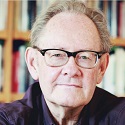I keep meaning to post these links and keep forgetting. But now that we’re snowed in—or, to be more accurate, frozen in (it’s minus 13 degrees here in Indian Hills as I write)—I have a moment free from “real” work to make the recommendation. Over at The Storialist, Hannah Stephenson has been experimenting with poetry and video (see here and here) in weekly posts under the rubric “Multimedia Fridays.” We are awash in images, of course—and according to the Slovenian philosopher and psychoanalyst Slavoj Zizek, “images are the true reality today.” So why should poetry not wed words to visual images? (We typically see it the other way around: artists wedding visual images to poetry, as haiga artist Kuniharu Shimizu does here with a sweet haiku from one of the best haiku poets around, Melissa Allen.*)
I have to say, though, that while I’m intrigued and energized by Hannah Stephenson’s experiments, in a larger sense I wonder if poetry should grant even more dominance to the image. Should poetry resist the visual? I don’t think well in poems, but I registered my discomfort with images many years ago in a poem from House of Mirrors:
The Geese
Across from the bus stop,
a pair of plump Canada
geese are flatfooting down
the clumpy knoll. Their rumps
sway, their draggled heads
darting glances to every side.
Just fifty wild generations back
such looks must have outfoxed
foxes; but here, in this
tiny suburban park laid out
among fenced-in houserows,
such wariness seems comical—
Ralph Cramden and Oliver Hardy
sneaking home after a night
with the boys….
How this
century of images has darkened
my spirit! Much as the park’s
pond waters have darkened: tainted
by road salt, mercury, malathion;
exhausted by decorator faucets,
by hoses, sprinklers and gutters.
So much of ourselves in those
furtive creatures; so much
of our lives in the shallow,
clouded waters.
The irony, of course, being that the poem is lousy with images! Certainly one way is the approach Göran Sonnevi uses in his great long poem Mozart’s Third Brain, so masterfully brought over into English by Rika Lesser. I mentioned here that I was reading the poem, but never got around to writing about in depth, and perhaps never will. Suffice it to say that Sonnevi’s strategy is not image-dependent and might provide a model for writing differently.
______________
* See more on haiga here.

 Joseph Hutchison, Colorado Poet Laureate 2014-2019, has published 20 collections of poems and edited or co-edited three poetry anthologies. He currently directs two master’s-level programs for University College at the University of Denver: Professional Creative Writing and Arts & Culture Management. Joe lives with his wife, Melody Madonna, in the mountains southwest of Denver, Colorado, the city where he was born.
Joseph Hutchison, Colorado Poet Laureate 2014-2019, has published 20 collections of poems and edited or co-edited three poetry anthologies. He currently directs two master’s-level programs for University College at the University of Denver: Professional Creative Writing and Arts & Culture Management. Joe lives with his wife, Melody Madonna, in the mountains southwest of Denver, Colorado, the city where he was born. 










Joseph, what a pleasure to stumble upon such an extravagant compliment, as well as to discover such a wonderful blog. I'll be following in future.<br /><br />I'm glad you enjoyed my and Kuni-san's collaboration. One thing that excites me so much about his haiga of my haiku is precisely that I tend to have a very abstract mind myself and my haiku are often (in my opinion) not visual
That reduction is one way, and a good one. Sometimes we get so addicted to images that the poem can't move forward—stuck in the underbrush. I'll have to look for <i>Dogville</i>. I used to live there. Woof.
I don’t think poetry can escape the visual but I guess it all depends on what the reader brings to the piece. And I don’t think this is a problem that only applies to poetry. It’s a reader’s <i>image</i>-ination after all that completes a piece. Personally I tend to reduce images to concepts. I don’t visualise. I’m reading a book just now where the author insists on describing everything and